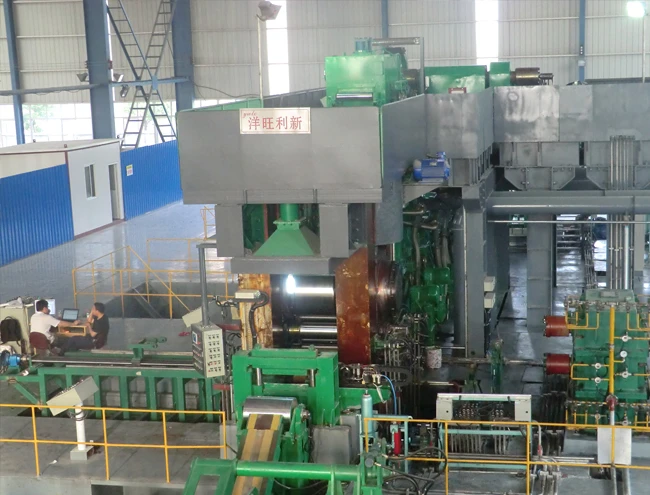
Cladding Rolling Mill: Precision Metal Cladding & Sustainable Manufacturing | YWLX
In the realm of metal processing, the Cladding Rolling Mill has emerged as a groundbreaking solution, offering enhanced surface quality, energy efficiency, and environmental sustainability. Developed by Beijing Yang Wang Li Xin Sci&Tech Co.,Ltd. (commonly known as YWLX), this technology addresses the limitations of traditional methods like hot roll bonding cladding and explosive cladding. This article delves into the technical features, advantages, applications, and the company's innovative contributions to the industry.
Technical Features of the Cladding Rolling Mill
The Cladding Rolling Mill leverages a cold rolling process to produce high-quality metal strips. Unlike conventional methods that require acid pickling or re-heating, this technology eliminates surface oxides, resulting in a superior surface finish. The absence of acid treatment not only reduces environmental impact but also simplifies the production workflow.

One of the standout features is its energy-efficient design. By eliminating the need for re-heating and acid pickling, the mill aligns with global NIST guidelines on energy conservation and environmental protection. This makes it a preferred choice for industries aiming to reduce their carbon footprint.
The process involves three primary stages: surface treatment before rolling, bonding rolling, and annealing treatment. This streamlined approach ensures a high yield rate (above 90%), lower production costs, and reduced capital investment, making it a cost-effective solution for manufacturers.
Key Advantages of the Cladding Rolling Mill
The Cladding Rolling Mill offers a multitude of benefits that set it apart from traditional cladding techniques:
- Superior Surface Quality: The cold rolling process prevents oxide formation, eliminating the need for acid pickling and ensuring a clean, uniform surface.
- Environmental Friendliness: By reducing energy consumption and chemical usage, the mill supports sustainable manufacturing practices.
- High Yield and Efficiency: With a yield rate exceeding 90%, the technology minimizes material waste and maximizes productivity.
- Cost-Effectiveness: Lower operational costs and reduced investment requirements make this technology accessible to a broader range of manufacturers.
These advantages are particularly relevant in industries such as clad pipe welding, where precision and durability are critical. The mill's ability to bond bimetallic or triple-metallic layers in a single production line further enhances its versatility.
Technical Specifications
| Parameter | Specification |
|---|---|
| Maximum Strip Width | 1000 mm |
| Minimum Thickness | 0.2 mm |
| Yield Rate | ≥90% |
| Energy Consumption | Reduced by 30% compared to traditional methods |
| Materials Supported | Copper-Steel, Aluminum-Steel, Copper-Aluminum, Aluminum-Stainless Steel, Stainless Steel-Steel |
Applications in Modern Industries
The Cladding Rolling Mill's adaptability makes it suitable for a wide range of applications:
- Electronics: High-conductivity copper-aluminum cladding is used in heat sinks and circuit boards.
- Chemical Industry: Corrosion-resistant stainless steel-clad materials are ideal for storage tanks and piping.
- Automotive: Lightweight aluminum-steel composites enhance vehicle efficiency without compromising strength.
- Construction: Decorative and durable cladding sheets are used in architectural facades.
For example, YWLX's technology has been successfully implemented in hot roll bonding cladding applications, producing strips with widths up to 1000 mm and thicknesses as thin as 0.2 mm. This precision meets the stringent demands of modern manufacturing.
About YWLX: Innovating Metal Cladding Technology
YWLX, based in Shijiazhuang, China, is a leader in developing advanced cladding solutions. The company's cold rolling cladding technology has redefined industry standards by addressing the limitations of traditional methods. Their expertise spans multiple material combinations, including copper-steel, aluminum-steel, and stainless steel-steel cladding.

YWLX's commitment to innovation is evident in its ability to produce bimetallic and triple-metallic bonds in a single production line. This not only reduces complexity but also ensures consistent quality. The company's technology has been adopted in industries requiring high-performance materials, such as clad pipe welding and explosive cladding applications.
Conclusion: The Future of Metal Cladding
The Cladding Rolling Mill represents a significant leap forward in metal processing. By combining cold rolling technology with environmental sustainability, YWLX has set a new benchmark for the industry. As global demand for energy-efficient and eco-friendly solutions grows, this technology is poised to become a cornerstone of modern manufacturing.
For more information about YWLX's products and services, visit their official website at https://www.bjywlx.com/cladding-rolling-mill.html.
References
National Institute of Standards and Technology (NIST). (n.d.). Energy Efficiency and Environmental Standards. Retrieved from https://www.nist.gov.
-
YWLX’s 1450mm Six-Hi Reversing Mill Goes Live in BangladeshNewsNov.24,2025
-
Adjusting Roll Gap in 6Hi Reversing Cold Rolling Mill for Thin StripNewsNov.13,2025
-
Quality Control Standards for Automatic Gauge Control in Strip RollingNewsNov.13,2025
-
Effect of Skin Pass Rolling on Metal DuctilityNewsNov.13,2025
-
Key Components of a Modern TempermillNewsNov.13,2025
-
Common Wear Patterns of Work Roll in Tandem Cold Mill OperationsNewsNov.13,2025
-
Revolutionary Skin Pass Rolling Technology for Enhanced Steel QualityNewsNov.04,2025










